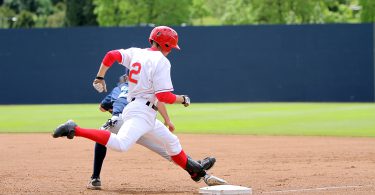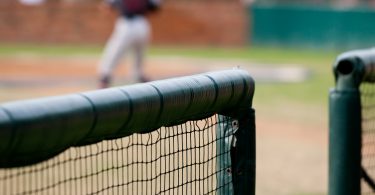The Situation:
There are runners at the corners with 1 out in the second inning of a tie ballgame.
The Play:
The batter lofts a single over the second baseman’s head. The runner from first gets a good read on the batted ball and has 3 on his mind. The right fielder charges in hard, looking to throw the runner out at third. As the right fielder gets to the ball, he bends down to collect the ball. As his glove is going down to meet the ball, it hops up and hits the heel of his glove. He fumbles it temporarily as he tries to recover.
The Outcome:
The batter who had been coasting towards first, sees the momentary fumble and starts running hard, realizing he has an opportunity to get an extra base. He accelerates towards second as the runner from first coasts into third and takes a small turn. The outfielder gathers the ball quickly and alertly throws it in to second base. The throw is low and hard and arrives on a long hop. The shortstop is there to receive it and slaps the tag down on the batter, who is punched out. There’s a runner on third with two outs and 1 run in.
What Went Wrong:
The offense misses out on an opportunity to really capitalize on the defensive mistake by the right fielder. Let’s address both mistakes on the play, one by the batter and one by the right fielder. With the pre-season ahead of you, there are things you can do to limit these mistakes from happening.
The batter’s mistake. Many preventable base running mistakes come from lack of anticipation, intent, and hustle. This one falls into that category. There’s never a reason for not running hard on the bases, but you already know that. Taking an extra base on a bobble comes from running hard and anticipating mistakes before they happen. If you want to take advantage of minor mistakes to the fullest, you need to be okay with putting in full effort with the understanding that it will often go unrewarded. That means creating a process that will lead to success the highest percentage of the time. The mentality of taking 2 starts out of the box, but the turn around first is just as important. Instead of slowing down around first base on an outfield single, maintain speed for as long as the play allows you to do so. Many times players slow up before they have to, and then must turn on the jets once a mistake is made. When you work on base running this spring, work on maintaining full speed as long as you can. Doing so will allow you the most time to capitalize on a defensive mistakes and get you accustomed to running with intent to take extra bases at all times.
The outfielder’s mistake. Outfielders, like infielders want to “work below the ball,” meaning they are in a better position to react to unexpected hops and work with their glove in one direction (from the ground up). The outfielders intention was good. He charged hard, cutting the distance to the ball, as he should. This time, he was a little late getting his glove down, creating a situation where his glove was moving down as the ball was hoping up. In other words, he was “working above the ball.” As an outfielder, timing is incredibly important. Getting down too early slows momentum and creates a rigid and nonathletic fielder. Incorporate speed pickups like this into your catch play routine. Work on cutting the distance, working below the ball and maintaining momentum through the catch. Stay athletic, prepare for success this spring in your daily routine, and think the game!







